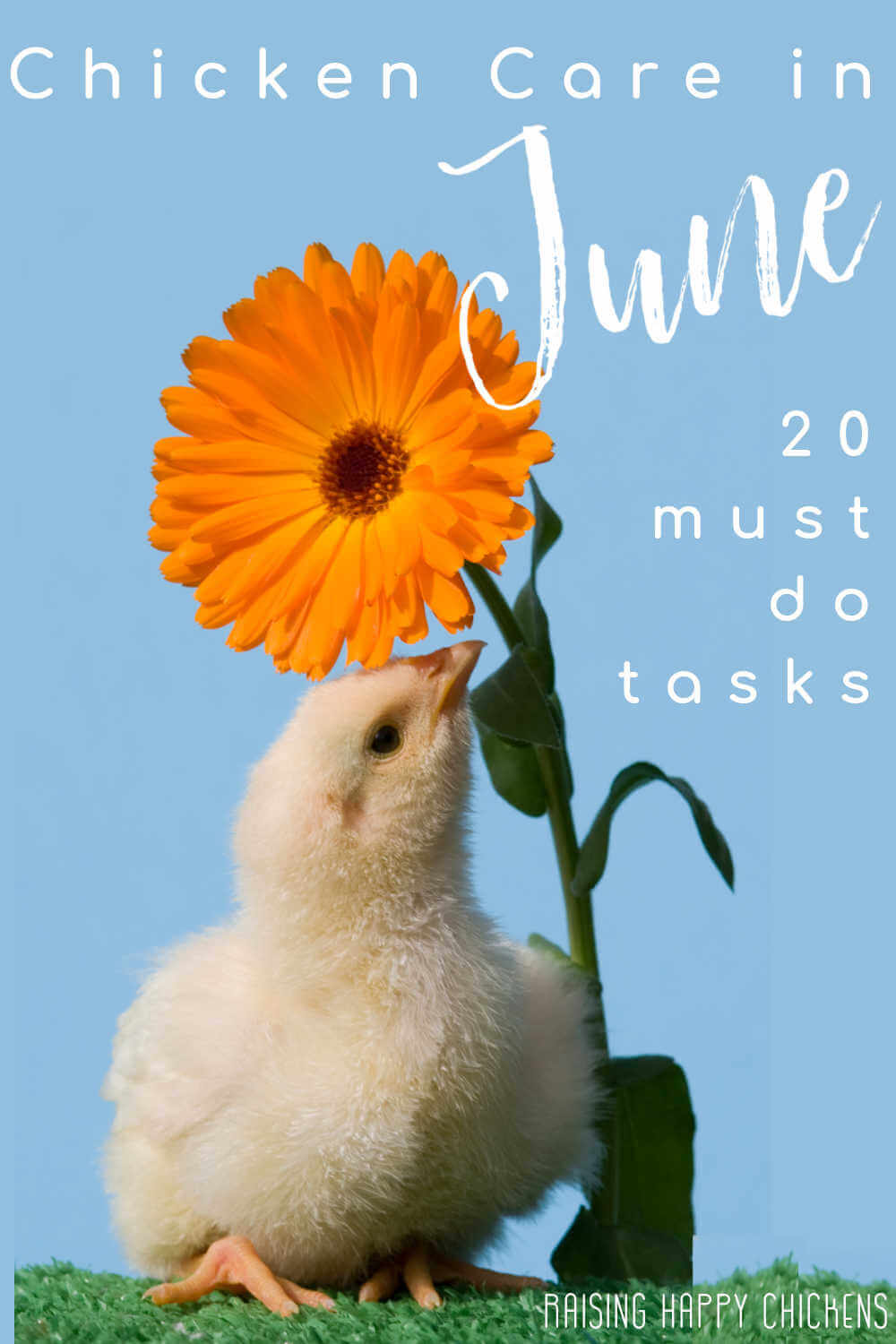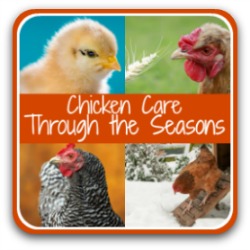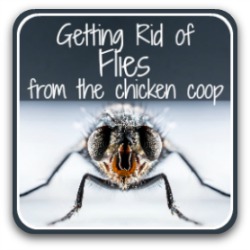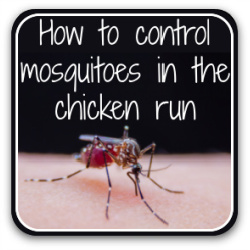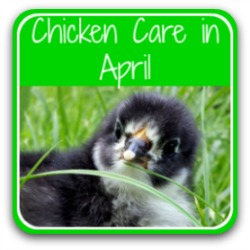- Home
- Monthly care
- June
Raising chickens in June: 20 tasks for this month in the coop.
Welcome to summertime! Days are longer, the weather is starting to warm up, and your flock will soon need help to cope.
So raising chickens in June will include enjoying extra daylight hours spent with our flock, while at the same time start planning for the hotter days ahead.
Why? Because chickens are far less able to cope with the heat than they are with the cold.
Want my "Raising Chickens in June" task checklist?
It's available for free to everyone who's subscribed to my "Chicken Digest" – a weekly newsletter. They receive each month's checklist at the start of the month – every month.
Check the tasks off online, or print it out to carry into the coop!
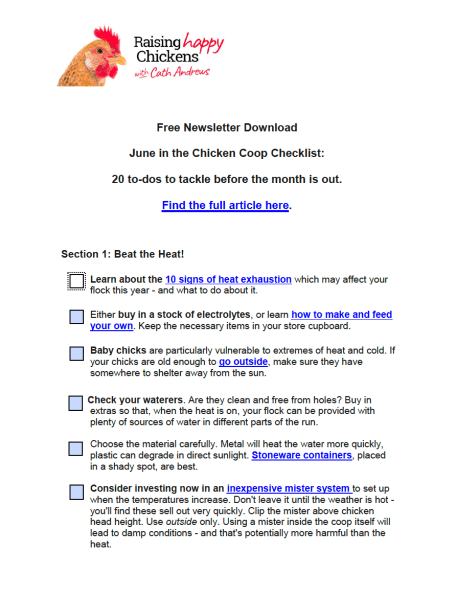
Not a Chicken Digest member yet? No problem – join here!
1. Plan for the heat!
The weather in your part of the world may not be terribly hot yet, but it will be soon!
Now's a good time to start planning for the hot summer days before they actually arrive.
Better to be prepared than to risk your chickens' health.
Although chickens are able to survive the cold well, heat is an entirely different issue. It's critically important to be able to detect when the temperature is becoming a problem for your flock – and to know what to do about it.
So we'll start this month by learning how to spot and deal with the symptoms of heat stroke.
What to do.
1. Learn about the 10 signs of heat exhaustion which may affect your flock this year – and what to do about it.
2. Either buy in a stock of electrolytes, or learn how to make and feed your own easily and inexpensively. Keep the necessary items in your store cupboard.
3. Baby chicks are particularly vulnerable to extremes of heat and cold. If your chicks are old enough to go outside, make sure they have somewhere to shelter away from the sun.
4. Check your waterers. Are they clean and free from holes? Buy in extras so that, when the heat is on, your flock can be provided with plenty of sources of water in different parts of the run.
Choose the material carefully. Metal will heat the water more quickly, and plastic can degrade in direct sunlight.
If you purchase a product through links on the rest of this page, I receive a small commission at no extra cost to you. I only recommend products I have purchased or would purchase myself and which I believe would benefit you. To learn more please see my disclosure policy.
A stoneware container like this, placed in a shady spot, is ideal.
5. Consider investing now in an inexpensive misting system to set up when the temperatures increase. Don't leave it until the weather is hot – you'll find these sell out very quickly.
This one is a favourite. It's easily attached by fixing up a rope across your run, or using an existing tree or fence. Clip the mister above chicken head height.
It's a simple system which can reduce the ambient temperature by around 20 degrees across a ten foot area. It does leave wet patches on the ground. Not to worry – they can help cool your flock's feet!
Use outside only. Using a mister inside the coop itself will lead to damp conditions which are potentially even more harmful than the heat.
 Patches of water from a mister - they can help your chickens' feet keep cool!
Patches of water from a mister - they can help your chickens' feet keep cool!Be careful about mosquitoes, though. They can gather around standing water, so stop using this if the water is pooling without drying out.
Otherwise you might discover the mosquitoes are causing more trouble than the heat. Chickens will eat mosquitoes, but they can also transmit a number of viruses including fowlpox and West Nile disease(1).
Are mosquitoes and flies a problem for you?
See this detailed article for more information about how to control mosquitoes in the chicken run.
2. Check ventilation.
As the weather warms up, and given that chickens poop a lot, there's a danger that moisture can build up in the air during the summer months.
Moist air does not go well with chickens. They have a delicate respiratory system with very thin air sacs which can easily become compromised.
Ammonia from a build-up of warm air and poop can damage the protective cells of the windpipe, making it easy for bacteria to invade(2).
So it's essential that your coop has excellent ventilation all year round, and particularly in the summer months.
What to do.
6. Check the ventilation in your coop is not blocked by dirt which has built up during the winter months. Clean if necessary so that there is a good flow of air.
7. Consider fixing a slider system to any existing windows in your coop so that air can circulate freely in the summer. In the winter they can be closed to prevent drafts.
This video is a good example of the kind of system that works well.
8. If you have electricity in your coop, consider installing a low speed fan. Turbo-fans are too powerful for what's needed here.
Place it above the heads of the chickens. Having it at chicken height will be uncomfortable for them.
Something like this is a good solution.
9. Make sure all openings are covered in hardware cloth (UK: galvanised mesh). Half inch square is the maximum size you should look for; quarter inch is better. It's inexpensive, and it could save your chickens' lives.
Chicken wire is not strong enough to deter determined predators!
10. Consider using sand in the coop during the summer months. The chickens love keeping cool by dust bathing in it, and there's no doubt it keeps the coop at a much cooler temperature than bedding such as straw.
It has the added advantage of vastly reducing the number of flies hanging round the coop, which makes it a much more pleasant environment for humans and chickens alike.
And it's fun finding those chicken-tracks, too!
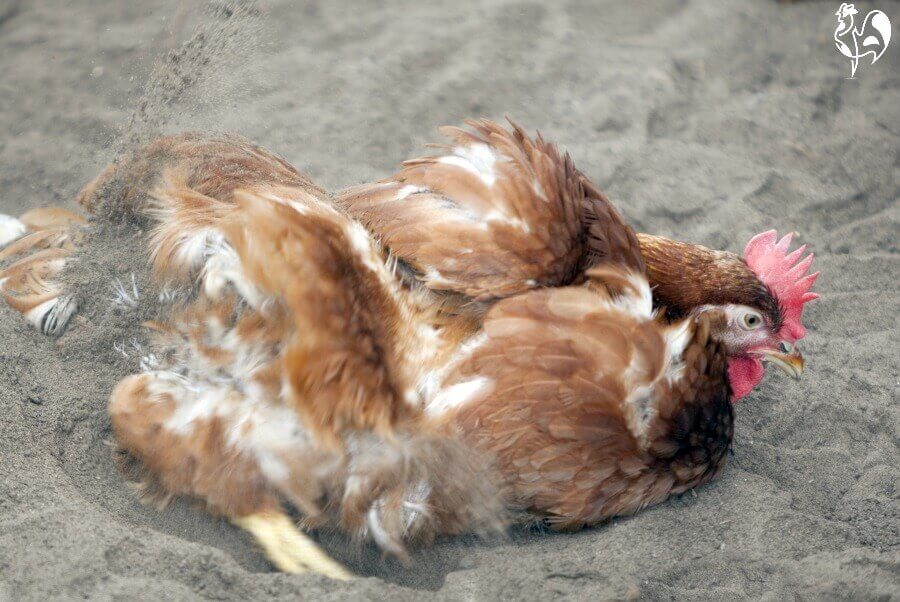 One of my Red Stars enjoying a sandy dust bath.
One of my Red Stars enjoying a sandy dust bath.3. Get rid of mites!
Last month we covered lice. This month it's mites!
As the weather warms up, these pests start to multiply. Before you know it, you can have an infestation spreading very rapidly through your flock.
Feeding off your chickens' blood, they can cause severe problems within your flock including falling egg production and anaemia which, in young or vulnerable birds, can ultimately be fatal.
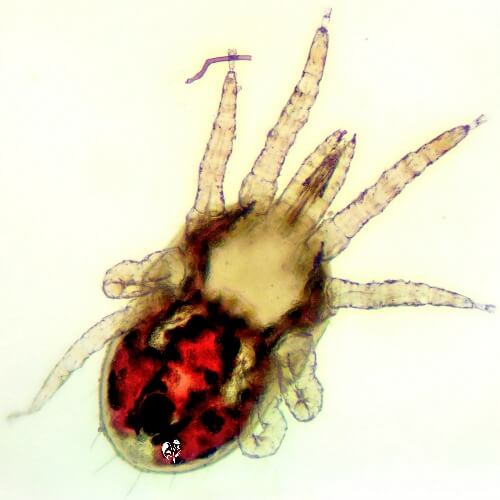 The red chicken mite, engorged on blood after a chicken feast.
The red chicken mite, engorged on blood after a chicken feast.What to do.
11. Check your flock once a week during the summer months. In particular, look for large grey-white clumps at the base of feathers, particularly around the vent area.
12. You won't see mites moving during the day – they tend to hide in the nooks and crannies of your coop and come out at night.
Try running a piece of white paper along the bottom of perches, or in places where the perch meets the wall. If the paper comes away red, you have mites.
13. In that case, you'll need to deep clean the entire coop, burning all bedding and disinfecting nest boxes, roosts, walls and floors – anywhere mites may hide.
14. For a heavy infestation you may need to use chemicals to cleanse the coop. Otherwise, there are natural ways to get rid of mites including using predator insects, food grade diatomaceous earth and wood ash.
15. Growing peppermint, garlic and lemongrass can be useful too. Sprinkle the dried leaves in nest boxes and bedding.
These herbs won't get rid of an infestation, but they're said to keep mites at bay. At the very least they'll make your coop smell heavenly!
16. For detailed information about how to spot, treat and prevent mites in your coop, take a look at this article.
4. Raising chicks? Watch their temperature.
If you hatched or bought chicks in April or May, they'll be at least a month old by now. Soon, if the weather in your area permits it, they'll be ready to go outside.
Even very young chicks enjoy being outside for an hour or two, as a break from the brooder. But if you're brooding them in your home, you'll soon tire of the smell, not to mention the noise. Time to think about them going outside not for a short break but for good.
But before they do, you need to prepare for their departure from the brooder.
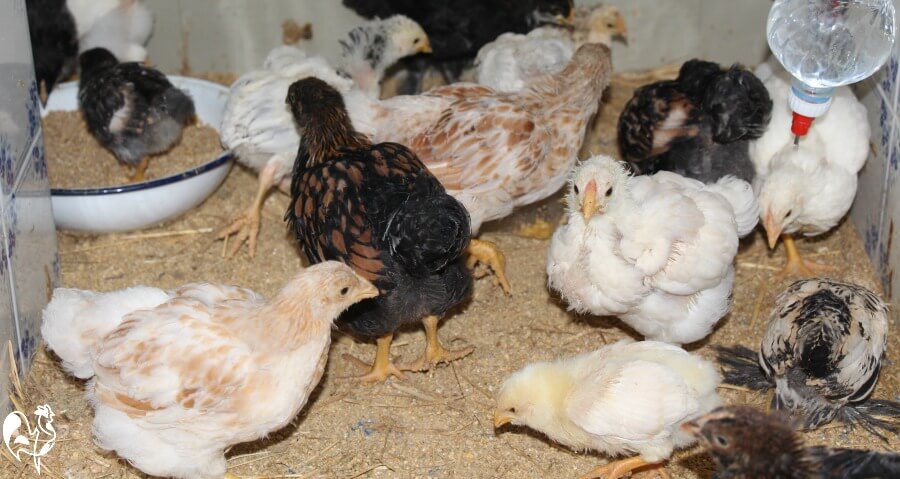 Brooded in my spare bathroom, ready for the great outdoors. And I was ready to see them go!
Brooded in my spare bathroom, ready for the great outdoors. And I was ready to see them go!What to do.
17. Don't put your chicks outside without extra heat if it's snowing, cold or wet. This is particularly true if they're still even partly covered in down (as opposed to being fully feathered) or if they're less than five weeks old.
They can go outside for short periods as a change from the brooder, but they must not live outside until they're fully feathered. Young chicks cannot control their temperature and will need a heat lamp to make sure they don't chill and die.
18. Do not put baby chicks into the same run as adult hens. Adults can be brutal, and there's a good chance they'll be killed.
Chicks raised by a broody hen are a different matter because she will protect them. But babies hatched in an incubator or bought from a hatchery or feed store are not able to protect themselves. And adults don't take kindly to "intruders" in the flock.
The pecking order can be ruthless. Make very sure chicks are big enough to take care of themselves before putting them outside, and keep them separated for several days until they get used to the sight and sound of each other.
19. Plan, plan, plan. How and where will you contain them while keeping them separate from the adults until they're big enough? Are there predators in your area, and if so how will you protect the chicks? Chicks become very good at learning to fly. How will you stop them literally flying the nest?
20. For much more detailed information about moving baby chicks outside, see this article.
 One of my Polish chicks enjoying a taste of the great outdoors for the first time.
One of my Polish chicks enjoying a taste of the great outdoors for the first time.When you've considered and undertaken all these tasks, your chickens should be healthy and happy this month.
Enjoy June with your flock!
If you enjoyed this article, you'll like these!
Sources.
A lot of "facts" you'll find on the internet are often people's individual views, often based on inaccurate information repeated from poor quality sources.
The information I provide in this article and others is based not just on my own experience, but on evidenced facts from scientific, peer-reviewed research and evidence from highly respected and experienced poultry keepers such as Gail Dammerow.
Some of the sources I have used are these - click the link to read the full document:
1. Murillo, Dr Amy: Flies, gnats and mosquitoes with poultry. Pub. MSD Veterinary Manual, 2021.
2. Shankar, B. P: Common Respiratory Diseases of Poultry. Pub. Veterinary World, 2007.
- Home
- Monthly care
- June
